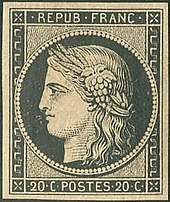 |
| France Ceres issue 1849 Source |
 |
| Corrientes 1 real stamp, 1856 Source |
(This post was based initially on Wikipedia's entry on Argenina's postal history)
The earliest Argentine stamps were issued by the separate provinces of Corrientes (1856-80) and Córdoba (1859-62), and the State of Buenos Aires (1858-59) - reflecting the reality that Argentina was hardly a single organised country in that period, but rather a loose federation of some very independent provinces.
The first Corrientes stamps were individually engraved by hand, so that each die is noticeably different, and were printed in small sheets. All stamps were printed on brightly coloured paper. The first stamp, issued in 1856, bore the denomination of one real in the lower panel. In 1860, the denomination was marked out by pen and the stamp was revalued at 3 centavos. Beginning in 1860, the value panel was erased and six more stamps were issued in two, three and (briefly) five centavos denominations, distinguished only by the colour of the paper used. As locally produced "primitives", the early Corrientes stamps have long been prized by collectors.
Louis Stich, an expert on the Corrientes stamps, has explained the origin of the issue as follows: In 1856 there was an extreme shortage in paper or coins under 8 Reales. At the same time, the Corrientes Assembly authorized stamps for pre-paid postal use. The State Printing Bureau decided to print stamps to serve both for postal use and for small change. The director of the State Printing Bureau, Paul Emile Coni, supposedly could not locate anyone capable of cutting the stamp dies. At that time, a baker’s delivery boy, Matias Pipet, who had served as an apprentice to an engraver in Italy before arriving in Corrientes, said he could undertake the task. Coni, for reasons unknown, selected the French Ceres stamp as the design and the boy prepared the designs. The dies produced were "so extremely crude" that Coni was afraid to use them, but he eventually decided that he had no choice as the need for the stamps was urgent. Stich observed that "with each re-telling" of this story, "more fiction seems to replace the original facts."
From 1864 to the first commemorative in 1892 a total of 24 different designs were issued. The majority of these stamp designs were small portraits of famous men, principally of the Independence period. The stamps do not identify these heroes of independence, so they would have meant little to anyone who was not familiar with Argentine history but rather represented “liberal” figures then current in Argentine political history, reflecting the principal trend after the fall of the dictator Juan Manuel de Rosas in 1852. The dominant figure was one of the major figures of Argentine liberalism, Bernardino Rivadavia.
The Popper locals
 |
| 1891 Tierra del Fuego "Popper" stamp Source |
The stamp itself has an interesting design, including mining tools, the “Tierra del Fuego” label, and a partially hidden letter “P” for Julius Popper.
Buenos Aires
 |
| Source |
Argentina Federal Stamps
The first stamp of Argentina as a nation was a rather crude lithographed seal of the Confederation in 1858.
 |
| Source |
This was followed in 1862 Argentina Coat of Arms, also known as “small shields” type, which were printed by Roberto Lange in lithography, containing 3 different values of 5c rose, 10c green and 15c blue, printed over the period 1862-4.
However, there are plenty of forgeries, most based the 5c reprint of 1864.

During the period 1862 to 1892, the Argentine stamp featured 24 different designs, mostly commemoratives.
Argentina philately (in Spanish)
You have provided very good information about Argentina Stamps and this is very important. People get a lot of benefit from reading such important information. Thank you so much for this information.
ReplyDeletePincodezone